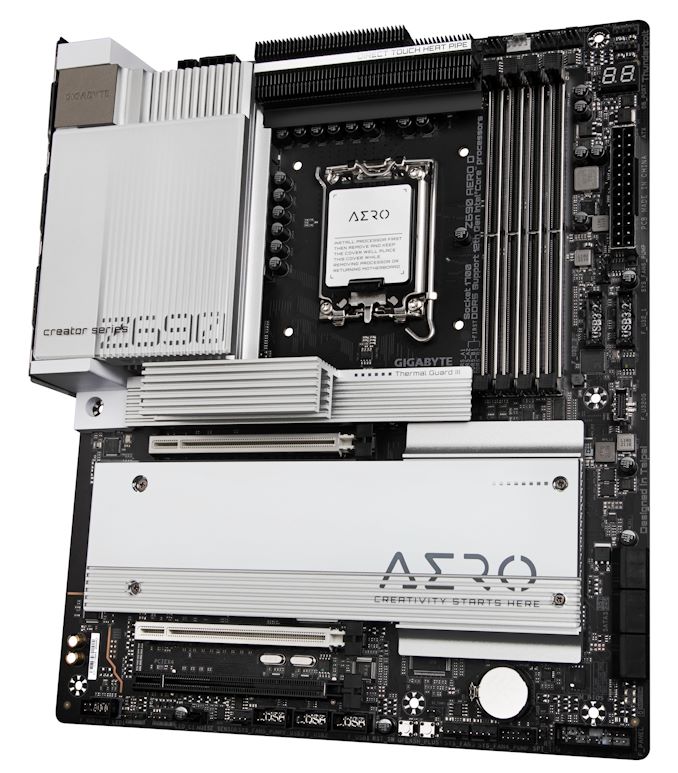The Intel Z690 Motherboard Overview (DDR5): Over 50+ New Models
by Gavin Bonshor on November 9, 2021 9:00 AM ESTGIGABYTE Z690 Aero D (DDR5)
Moving away from the gaming-focused Aorus branded motherboards, and GIGABYTE has announced its content-creator-friendly Aero series will be making a return for Z690. The GIGABYTE Z690 Aero D is a solid representation of this with plenty of premium controllers, high-end features, and good compatibility with external devices. Focusing on the design, the Z690 Aero D is decked out in a contrasting black and silver aesthetic, with a classy large rear panel cover, with silver heatsinks throughout which covers the majority of the PCB. GIGABYTE has also omitted any integrated RGB LED lighting, which is typical of it for its Aero series of motherboards.
Dominating the lower half of the board on the GIGABYTE Z690 Aero D is a pair of full-length PCIe 5.0 slots that can operate at x16 and x8/x8, with a third full-length slot electronically locked down to PCIe 3.0 x4. For M.2 storage, there are four PCIe 4.0 x4 M.2 slots, while only one of these supports SATA-based drives. The Z690 Aero D also includes six SATA ports with support for Intel RAID 0, 1, 5, and 10 arrays. Located in the top right-hand corner is the board's memory slots, with GIGABYTE including four with support for DDR5-6400, and a combined capacity of up to 128 GB.
Looking at the rear panel of the GIGABYTE Z690 Aero D, and this is where all of that content-creator-friendly goodness is. It includes dual Thunderbolt 4 Type-C ports, with six USB 3.2 G2 Type-A ports, and a pair of video ports including one HDMI 2.1 video output and one DisplayPort 1.4 video input. The board's networking configuration is high-end, with an Aquantia AQC107 10 GbE and Intel I225-V 2.5 GbE controller pairing, with an Intel AX210 Wi-Fi 6E CNVi providing both wireless and BT 5.2 connectivity. Integrated audio options are basic, with just two 3.5 mm audio jacks that finish off a premium, yet interesting rear panel layout.












126 Comments
View All Comments
Dahak - Tuesday, November 9, 2021 - link
Will there be a list of DDR4 only board as well?Ryan Smith - Wednesday, November 10, 2021 - link
Yes, we're also putting together a guide for DDR4 boards.jh20001 - Wednesday, December 1, 2021 - link
Any news on the DDR4 story? Would be nice to know what model is the best for performance/features in the eyes of others.Flunk - Tuesday, November 9, 2021 - link
Intel's actually released a compelling new chipset? I'm surprised to see DDR5 and PCIe 5 support, but USB 4 seems to be notably absent, despite there being no reason at all to omit it. Intel is finally one-upping AMD after a few years of playing #2.Exotica - Tuesday, November 9, 2021 - link
Thunderbolt4 is usb4 capable…CharonPDX - Tuesday, November 9, 2021 - link
Yep, the only thing USB4 adds over "USB 3.2 2x2" is Thunderbolt support. Therefore any Thunderbolt 4 device is automatically USB4. In fact, essentially any board with "Thunderbolt 3" along with USB 3.2 2x2 basically get "USB4" status for free.DigitalFreak - Tuesday, November 9, 2021 - link
USB 3.2 2x2 is 20 Gbps. USB 4 is 40 Gbps.12345 - Wednesday, November 10, 2021 - link
That's why they mentioned TB3. 40Gbps support is also optional for USB4.12345 - Wednesday, November 10, 2021 - link
DP 2.0 is mandatory for USB4 so TB3 support isn't good enough.KarlKastor - Wednesday, November 10, 2021 - link
That is only the name. The question is, with what speed you can run USB devices.